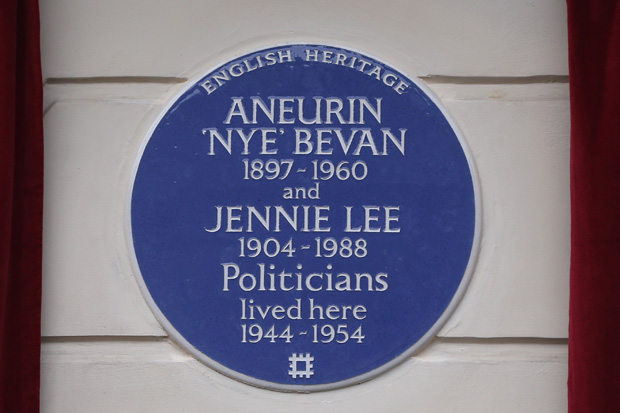Blue plaque spotting is one of the mind-broadening pleasures of British life. A walk to the dentist can be transformed into a serendipitous encounter with a forgotten genius from the past. ‘Luke Howard, 1772–1864, Namer of Clouds, lived and died here,’ says the blue plaque on 7 Bruce Grove, Tottenham. Even if you’ve never heard of Luke Howard, you instantly take a liking to him — and never again will you hear the word ‘cumulonimbus’ without thinking of him. ‘Lived here’ is the key: you’re passing the very house where the person woke up for breakfast each day, and the intimacy of that is what makes the encounter so much more affecting than merely reading about him or passing a statue of him.
But do you get the feeling that plaques are more ubiquitous, and therefore less frisson–inducing, than they used to be? They seem to be popping up all over the place. Most city councils now run blue plaque schemes and erect hundreds of the things. Last month a blue plaque was put up in London to commemorate the soft-porn star Mary Millington, ‘one of the hottest British sex film stars of the 1970s’, as Mail Online put it, combining a sense of salivating outrage with an excuse for dredging up photos of Millington in busty bikinis. On Midsummer’s Day 2013, in Brighton, a blue plaque to commemorate Doreen Valiente, ‘poet, author and mother of modern witchcraft’, was unveiled on the high-rise council block where she lived. The ceremony was attended by the mayor of Brighton and by hundreds of wildly celebrating pagans, some of them dressed as trees and banging green tambourines.
‘What is the world coming to,’ the purist blue plaque spotters among us fret, ‘if sex-film stars and witches are now being commemorated along with Winston Churchill and William Makepeace Thackeray? I’ll write a letter of complaint to English Heritage…’
But before you write that letter, halt! Have another look at that Mary Millington plaque. On closer inspection, it commemorates the film Come Play with Me, starring Millington, which ran at the Windmill Theatre for four years when it was still a cinema. It’s screwed to the wall of the Windmill Theatre. The words at the top of the roundel are not ‘English Heritage’ but ‘Great Windmill Street’.
Those are telltale signs. It’s not a fake blue plaque, exactly — it is blue and a plaque — but it has not passed the rigorous standards imposed by English Heritage, who took over from the Greater London Council in 1986, who followed on from the London County Council in 1965, who followed on from the Royal Society of Arts, who started London plaques exactly 150 years ago. English Heritage plaques are never screwed to the wall. They’re embedded into the brickwork or stucco so as to be flush with the wall, their convex surface making them self–cleansing and thus eternally gleaming. They are objects of great beauty, marred only perhaps by the small English Heritage ‘-castle-plan’ logo at the bottom. They’re never made of metal, but are ceramic, two inches thick and handmade by master ceramicists in Cornwall. Funded solely by donations, they cost almost £4,000 each to make and install, and it shows. A panel of historians meets three times a year to decide, from the hundreds of suggestions from the public, which should be shortlisted, and months are spent researching each person’s eminence and genuine association with the property in question, in order to whittle the shortlist down to about ten a year.
‘We have no copyright on the colour of plaques,’ says Howard Spencer, English Heritage’s plaques historian, ‘but we do say to others, “Try to make your style of plaque a bit different from ours.” ’ Other people do copy the style, however, just as people copy Prada handbags. It takes a discerning eye to tell a genuine English Heritage plaque from a copycat one.
There’s no law against any of us putting up a blue plaque wherever we like, as long as the owner of the property agrees and it’s not against planning regulations. For £24.99 you can buy a personalised ‘Heritage Plaque’ and have the words of your choice written on it, for example, ‘Aimee, born 1976, Party Queen and Best Friend in the World Lives Here.’ Some people have become so impatient with English Heritage’s exquisitely slow, rigorous process that they have started speedier and less strict plaque schemes of their own. An enterprising man called David Graham runs the Heritage Foundation and has started putting up plaques all over London commemorating celebrities from the world of showbiz and sport. ‘We have raised lettering on our plaques now,’ he proudly tells me. ‘They cost about 300 quid. I like to wait a year after someone’s died before putting one up.’ A year! English Heritage insists on 20 years after death. The British Plaques Trust set themselves up three years ago and have erected plaques (blue, metal, screwed to the wall) to commemorate, among other things, Tin Pan Alley and the house in China-town where the Magic Circle was formed. The Marchmont Association in Bloomsbury have put up 20 plaques since 2009, including one to the cross-dressers Stella and Fanny. Annoyed about Graham Chapman’s rejection by English Heritage, fans of Monty Python put one up in memory of him which reads ‘Jacob von Hogflume, 1864–1909, inventor of time travel, lived here in 2189.’ (Only fairly funny.)
As David Hare rightly said at a recent English Heritage plaque unveiling, ‘blue plaques are the only distinction that anybody really wants in life’, and ‘the great thing about it is they never know they have it’. The 20-years-after-death rule needs to be adhered to if we want to avoid a tide of over-commemorated celebs who don’t deserve ceramic or even metallic immortality.

| Will Britain vote to leave the EU? Can the Tories survive the aftermath? Join James Forsyth, Isabel Hardman and Fraser Nelson to discuss at a subscriber-only event at the Royal Institution, Mayfair, on Monday 20 June. Tickets are on sale now. Not a subscriber? Click here to join us, from just £1 a week. |
Get 10 issues for just $10
Subscribe to The Spectator Australia today for the next 10 magazine issues, plus full online access, for just $10.













